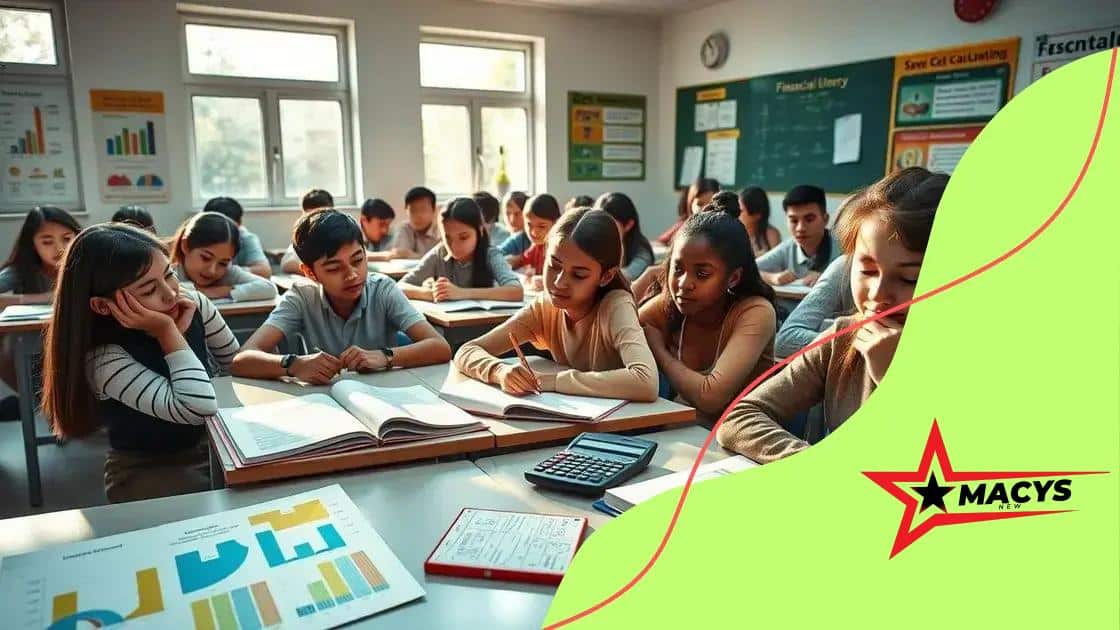Financial literacy programs in schools: a pathway to success

Financial literacy programs in schools equip students with essential skills for managing money, involving parents and communities to enhance learning and promote better financial decisions for the future.
Financial literacy programs in schools are essential for equipping students with critical money management skills. Have you ever wondered how understanding finances can influence a young person’s future? Let’s dive into how these programs can shape success.
Importance of financial literacy in today’s world
The importance of financial literacy in today’s world cannot be overstated. With the growing complexity of financial products and services, understanding how to manage money is essential for everyone.
Students, in particular, need to be equipped with skills that will last a lifetime. Knowing how to budget, save, and invest lays the groundwork for financial stability and success in adulthood.
Why financial literacy matters
Financial literacy provides individuals with the knowledge they need to make informed decisions about their money. It helps them understand:
- The value of good financial planning.
- How credit works and its implications.
- The importance of saving for emergencies and future goals.
These skills are vital for navigating the financial landscape effectively. Young people who grasp these concepts early tend to make better financial choices as adults.
Moreover, financial literacy programs teach students about the dangers of debt. Understanding how to manage debt can lead to more responsible borrowing and better credit scores.
Building a foundation for the future
Education in financial matters today can create a generation of knowledgeable adults. Financial literacy lays the foundation for:
- Greater economic empowerment.
- Informed decision-making regarding loans and credit.
- Better management of personal finances.
Being financially literate enables individuals to contribute positively to society. They are more likely to make responsible financial decisions that benefit not just themselves, but also their families and communities.
In a world where financial challenges abound, understanding money management is essential. It is clear that promoting financial literacy in our schools is an investment in a brighter future.
Key components of effective financial literacy programs
Understanding the key components of effective financial literacy programs is essential for creating successful initiatives in schools. These programs are designed to equip students with the necessary skills for financial management.
An engaging and practical curriculum forms the backbone of any strong program. It should address real-world scenarios, helping students relate their lessons to everyday life. Interactive activities and discussions enhance understanding, making learning enjoyable.
Essential elements of a successful program
Effective financial literacy programs include:
- Relevant content: The curriculum should cover topics like budgeting, saving, investing, and understanding credit.
- Hands-on experiences: Students benefit from simulations that allow them to practice financial decision-making.
- Skilled instructors: Educators must be well-trained and passionate about teaching financial concepts.
Moreover, involving students in real-life financial tasks can strengthen their knowledge. For example, creating a budget for a class project teaches practical skills that will be invaluable in their futures. By applying lessons in real situations, students are likely to retain the information longer.
Additionally, adaptations for different learning styles can make a program more inclusive. Workshops that cater to visual, auditory, and kinesthetic learners allow all students to engage effectively. This ensures that the teaching methods resonate with a diverse student body.
Community involvement
Bringing the community into financial literacy programs can also enhance their effectiveness. Involving local businesses, financial institutions, or volunteers gives students access to a range of perspectives and expertise.
These partnerships can lead to mentorship opportunities and provide students with resources that they might not otherwise have. Moreover, hosting community events focused on financial education promotes a culture of financial awareness and responsibility.
How schools can implement these programs

Understanding how schools can implement financial literacy programs is crucial for creating impactful educational experiences. There are several strategies that can be employed to ensure these programs are effective and engaging for students.
First, schools should integrate financial literacy into existing subjects. By weaving financial concepts into math, economics, and social studies classes, students can see the connections between their lessons and real life. This integration makes it easier for students to grasp concepts like budgeting and savings.
Developing a structured curriculum
A well-defined curriculum that outlines key topics is essential. Schools can start by focusing on:
- Budgeting and planning personal finances.
- Understanding credit scores and loans.
- Investment basics and the importance of saving.
This framework provides a solid foundation for teaching students about money management. Engaging lesson plans that include games and simulations can also enhance the learning experience.
Another effective approach is to collaborate with local financial institutions. These organizations often offer resources, guest speakers, and workshops. Such partnerships enrich the program by bringing in real-world expertise. Guest speakers can share experiences and provide insights that spark student interest.
Training teachers
Teacher training is another vital aspect of a successful implementation. Educators need to be comfortable with financial concepts and confident in delivering the material. Professional development workshops can help teachers learn innovative ways to engage students in financial literacy.
Furthermore, schools should create a supportive environment that encourages financial discussions. Providing resources like budgeting tools and financial apps can empower students to take charge of their financial education. From classroom activities to homework assignments, practical applications of financial concepts encourage students to apply what they learn.
Success stories: schools making a difference
Success stories from schools highlight the impact of financial literacy programs on students and communities. These programs can lead to significant changes in students’ attitudes towards money management.
For instance, many schools that have implemented comprehensive financial literacy curricula report improved student engagement and understanding of financial concepts. In one example, a high school in California integrated personal finance classes into their core curriculum. Students learned about budgeting, saving, and investing in a hands-on environment.
Positive outcomes from effective programs
These initiatives have shown several positive outcomes:
- Increased financial confidence: Students feel more prepared to manage their finances after completing the program.
- Better academic performance: Schools observing that students perform better in other subjects, like math, when financial concepts are integrated.
- Community engagement: Programs that involve local businesses often lead to mentorship opportunities for students.
Another notable story comes from a middle school in Texas, which partnered with community banks to offer workshops on credit and loans. As a result, students participated in real-life simulations where they managed mock budgets. Teachers reported that students were more knowledgeable and shared their newfound understanding with family members, creating a ripple effect.
Feedback from parents has also been overwhelmingly positive. Families appreciate the knowledge their children bring home. In some cases, parents became more involved in financial discussions as a result of these programs. Schools are creating a culture of financial awareness that extends beyond the classroom.
Transforming lives
These success stories illustrate the transformative power of financial literacy in education. Schools are not only teaching students money management skills; they are changing lives and shaping future generations.
Programs that foster collaboration between teachers, students, and the community are setting the stage for lasting impact. By focusing on real-world applications and engaging learning experiences, these schools are proving that financial literacy is a vital part of education.
Engaging parents and communities in financial education
Engaging parents and communities in financial education is a vital aspect of successful financial literacy programs. When families and local organizations get involved, students benefit from a richer understanding of financial concepts.
One effective strategy is to hold workshops where parents can learn alongside their children. These sessions can cover important topics such as budgeting, saving, and the importance of credit. By participating together, families can strengthen their financial skills and discuss practical applications at home.
Building partnerships
Schools can also collaborate with local businesses and financial institutions. These partnerships can bring in knowledgeable speakers who share real-world experiences. Guest speakers can discuss managing finances, saving for college, or investing wisely.
Additionally, schools might invite community members to support financial literacy events, such as:
- Hosting community fairs focused on financial education.
- Offering free resources like budgeting templates and financial planning guides.
- Providing access to financial planners for one-on-one consultations.
These activities not only engage parents but foster a sense of community ownership over financial education. Schools can promote these events through newsletters, social media, and word-of-mouth to encourage attendance and participation.
Moreover, schools should encourage parents to share their experiences with money management. This can create valuable discussions and help students see real-life applications of what they learn. Stories about overcoming financial challenges or saving for a goal can inspire students and provide practical lessons.
Creating a culture of financial literacy
When the community actively participates in financial education, it promotes a culture of financial literacy. This culture can lead to better financial decisions in families, ultimately benefiting the school and community as a whole.
To sustain this momentum, schools should continue to seek feedback from parents and community members. Understanding their needs and expectations can help schools improve their financial literacy programs effectively.
FAQ – Frequently Asked Questions about Financial Literacy Programs in Schools
What is financial literacy and why is it important for students?
Financial literacy refers to the ability to understand and manage financial resources effectively. It is crucial for students as it equips them with essential skills to make informed decisions about budgeting, saving, and investing.
How can parents get involved in financial literacy programs?
Parents can participate by attending workshops with their children, volunteering with local financial institutions, and discussing financial topics at home to reinforce what students learn in school.
What are the benefits of community partnerships in financial education?
Community partnerships provide students with real-world insights and resources. Local businesses and experts can offer mentorship, host workshops, and enhance real-life learning experiences.
How do financial literacy programs impact student performance?
Research shows that students engaged in financial literacy programs often demonstrate improved academic performance and greater confidence in managing their finances, leading to better decision-making in adulthood.





